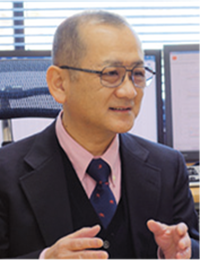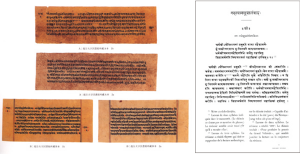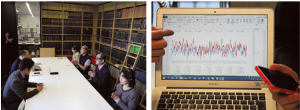キーワード: 瑜伽行唯識(ゆがぎょうゆいしき)思想、大乗仏、修行、脳科学、認識論、認知科学、東洋哲学、西洋哲学
 物理学者のアインシュタインは次のような言葉を残しています。【Body and soul are not two different things, but only two different ways of perceiving the same things. Similarly, physics and psychology are only different attempts to link our experiences together by way of systematic thought.( Bite-Size Einstein: Quotations on Just About Everything from the Greatest Mind of the Twentieth Centuryからの引用)(邦訳:体と魂は異なるものではなく、同一の事柄を二つの方法で認識しているにすぎない。同様に、物理学と心理学とは、体系的な思考によって私たちの経験を結び付ける異なる試みにすぎない。)】敬虔なクリスチャンであった彼は、本リサーチユニットで対象としている「こころ」を表現しているのかも知れません。本リサーチユニットでは、人文科学(仏教学)と自然科学(脳科学)の双方から、「あるがままの姿」をとらえる方法論を見つけようとするものです。
物理学者のアインシュタインは次のような言葉を残しています。【Body and soul are not two different things, but only two different ways of perceiving the same things. Similarly, physics and psychology are only different attempts to link our experiences together by way of systematic thought.( Bite-Size Einstein: Quotations on Just About Everything from the Greatest Mind of the Twentieth Centuryからの引用)(邦訳:体と魂は異なるものではなく、同一の事柄を二つの方法で認識しているにすぎない。同様に、物理学と心理学とは、体系的な思考によって私たちの経験を結び付ける異なる試みにすぎない。)】敬虔なクリスチャンであった彼は、本リサーチユニットで対象としている「こころ」を表現しているのかも知れません。本リサーチユニットでは、人文科学(仏教学)と自然科学(脳科学)の双方から、「あるがままの姿」をとらえる方法論を見つけようとするものです。
「こころ」でとらえる「あるがままの姿」

図1:『大乗荘厳経論』の写本と校訂本(サンスクリット語)
私たちは、目の前にある「あるがままの姿」を、五感を通して切り取り、脳が司る概念を通して抽象一般化することで「もの」として認識しています。本リサーチユニットでは、「あるがままの姿」を「もの」に変換する概念(心・理性)と「あるがままの姿」とのギャップを超越して「生命」そのものとして存在している状態をそのこころ」と呼んでいます。本リサーチユニットの研究目的は、仏教思想の側面と脳科学・認知科学の側面とから、瑜伽(ヨーガ)行の実践により「こころ」で「あるがままの姿」をとらえる(= 固定概念からの解放)認
識過程を考察し、両分野の隔たりを解消することです。
「こころ」に対する学際的研究に期待!
修行者の体験を言語で表現した初期の頃の唯識文献(論典)には、「あるがままの姿」をいかに悟ったかが記録されています。人文科学では、こうした過去の文献に残された記録(図1)をもとに、当時の人の思想や経験をとらえる研究を進めています。また、認知心理学などでは、脳波を計測することなどにより、「もの」の認識過程を客観的なデータでとらえる研究がされています(図2)。後者の自然科学的方法論研究者と前者の瑜伽行唯識研究者が互いの理論を各々の言葉で読み替えることができれば、「こころ」を学際的に新たに定義することができるはずです。
そのために、人文・自然科学両分野の考え方の隔たりを埋めながら研究を行っていきます。その結果、東西哲学分野で自然科学など他分野の研究成果を活用する方法論、もしくはその逆の活用に広がりを持たせる効果が期待されます。

図2:脳波測定現場と同一環境で4名同時計測された脳波
社会への貢献・実績
本ユニットはスタートしたばかりとのことで、実績はこれから生まれてくると期待しています。生命の基本である「こころ」を幅広く扱うことで、
(1)我々が生まれてからどのように世界を獲得してきたかなど乳幼児発達心理学、
(2)世界との関わりから精神疾患の大本がどこにあるかなど精神医療、
(3)健常・障害の別なく人間としてのこころのあり方を考えることでの倫理的な貢献
が期待できます。また私たち日本人の心の奥底にある(無宗教と誤ってイメージされている)「神様仏様への深い思い」の再発見をすることが出来るかもしれません。
(取材:平成26年11月13、28日)
“Mind” mastered through training - through interdisciplinary collaboration between humanities and natural sciences -
Unit name: Dynamics of Kokoro: An Interdisciplinary Study of the Mind Based on Mental and Physical Practices
Keywords: Yogācāra-Vijñānavāda thought, Mahāyāna, spiritual practice, brain science, epistemology, cognitive science, Oriental philosophy, Western philosophy
 Einstein, a physicist, said: “Body and soul are not two different things, but only two different ways of perceiving the same things. Similarly, physics and psychology are only different attempts to link our experiences together by way of systematic thought.” (Bite-Size Einstein: Quotations on Just About Everything from the Greatest Mind of the Twentieth Century). Einstein, a devout Christian, may have used these expressions to explain the “mind,” the research unit’s subject of research. The unit aims to identify methodologies for viewing “things as they are” from the viewpoints of both humanities (Buddhism) and natural science (brain science).
Einstein, a physicist, said: “Body and soul are not two different things, but only two different ways of perceiving the same things. Similarly, physics and psychology are only different attempts to link our experiences together by way of systematic thought.” (Bite-Size Einstein: Quotations on Just About Everything from the Greatest Mind of the Twentieth Century). Einstein, a devout Christian, may have used these expressions to explain the “mind,” the research unit’s subject of research. The unit aims to identify methodologies for viewing “things as they are” from the viewpoints of both humanities (Buddhism) and natural science (brain science).
“Entities as they are” perceived by the “mind”

Fig. 1: Manuscript folios and a critical edition of the “Mahāyāna-sūtra-alaṃkāra” (written in Sanskrit)
We see and perceive an “object” by recognizing it “as is” through our five senses and abstracting and generalizing it using conceptual functions controlled by the brain. The research unit defines “mind” as a form of “life” that exists without being influenced by the gap between “things as they are” and concepts (mind/rationality) to perceive them as entities. The research unit aims to discuss the process of cognition whereby the “mind” perceives “things as they are” (free from stereotypes) through yoga training from the perspectives of Buddhist thought and brain/cognitive science so as to reduce the gulf between these two academic fields.
Expectations for interdisciplinary research on the “mind”
Early literature on vijñapti-mātratā (the theory that all existents are subjective and nothing exists outside the mind), which gave verbal expression to the experiences of practitioners, includes accounts of how they realized the importance of viewing “things as they are.” Humanities research aims to examine the thoughts and experiences of people in the past, based on records found in works written at the time (Fig. 1). Researchers in cognitive psychology measure brain waves to examine the process of perceiving “entities” based on objective data (Fig. 2). Researchers using the methods of natural science and researchers of the Yogācāra-Vijñānavāda school will be able to redefine the “mind” using interdisciplinary approaches if they can interpret each other’s theories in their own terms.
Towards this end, the research unit conducts research while reducing the gulf between the viewpoints of researchers in the humanities and natural science. We hope that our research will lead to methodologies for applying the results of natural science and other research to Oriental and Western philosophies, and methods for broadening the range of applications of these philosophies to natural science and other areas.

Fig. 2: Brain waves of four people measured at the same time in an environment equivalent to a measurement laboratory
Social contributions and achievements
It is hoped that the research unit, which was established only recently, will produce significant outcomes. The unit conducts research on a variety of subjects related to the “mind” – the basis of life – and will contribute to:
(1) Infant developmental psychology: How has each of us established our own world since we were born?
(2) Psychiatry: Analyses of our interactions with the world to identify the underlying causes of psychiatric disorders.
(3) Ethics: Discussion of human states of mind, of both normal and disabled persons.
This research may help us rediscover the “profound feelings towards God and Buddha” that are present deep in the hearts of the Japanese people (who are mistakenly believed to have no religion).
